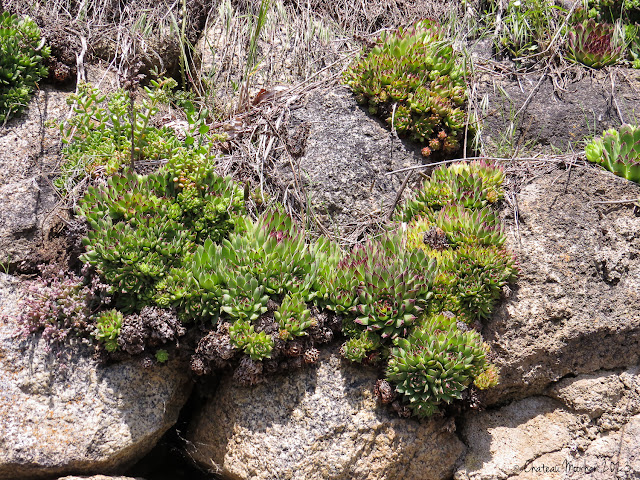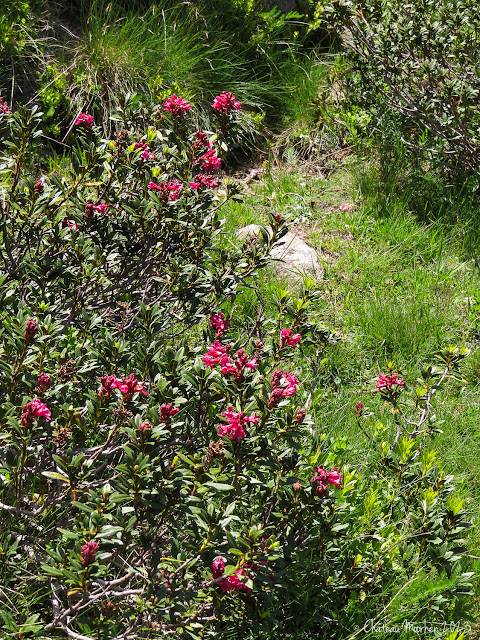On our last day, after seeing the Marmots, we set off into the hills, towards the village of Railleu. On the way, we stopped beside some valleys to look at the wildflowers and also to check for Red-backed Shrikes, which had been spotted here before. I don't have any photos as it was distant, but we did get to see one through a scope!
Whilst the birders were finding birds for us, those of us who were interested in other things had a good look around.
Glanville Fritillary (Melitaea cinxia).
I'm pretty sure this is an Adonis Blue (Polyommatus bellargus).
This is a tiny broom growing out of a rock bank, called the Winged Broom (Genista sagittalis).
We stopped for a wander around the village of Railleu, a pretty little place perched on a rocky hillside. When a group had been here the year before (later on in June) on a butterfly trip, they had seen dozens of butterflies of about 20 different species, but not so when we were there! It was a nice place to wander around anyway, admiring both the wildflowers and the little gardens beside the pretty stone houses and church.
Houseleeks (Sempervivum) growing on the rocks, the host plant of the Apollo butterfly.
We ate our picnic lunch at Railleu and then our group split up as it was the end of our trip. Keith and I weren't ready to go home though; as we were already up in the mountains it would have been crazy not to take advantage of it!
So after lunch we headed off to Lac de Bouillouses which is a large lake at 2,000m altitude. It was busy though - hardly any room left to park and people everywhere! It came as a bit of a shock after our quiet couple of days. In the summer they run a shuttle bus up here from a large car park about 10km away which is very sensible.
There were lots of horses wandering around too, including a number of cute foals. We also bumped into Niall beside the lake, who had had the same idea as us!
A rather alpine looking hotel, with lots of yellow broom in the foreground.
These heavy horses look very much like Bretons to me!
As we were walking around the path, some Citril Finches (Carduelis citrinella) came to land on the grass right near us. I took photos zooming in as I clicked, but most annoyingly some people walked around the corner and scared them off. Grrrr!
Here we were able to see the Alpenrose (Rhododendron ferrugineum) close up.
As the track beside the lake turned rather rocky we decided to give it a miss and stopped at a few places downstream of the River Tet, which isn't much of a river at this point as it is regulated by the barrage at the Lac de Bouillouses, though it becomes one of the major rivers in the Pyrenees Orientales dept when it gets down to the plain near Perpignan. We once stayed at a campsite beside this stream in an environment just like this. I think it was one of our most favourite campsites. It was a shame that the grass had all been grazed here too so there were hardly any wild flowers.
Before we got back to a main road, I stopped for a 'comfort break' in a field. I was admiring the nice field margin of wildflowers before the wheat crop started, then noticed the flowers amongst the wheat. I was amazed - this is the first time I have ever seen traditional cornfield flowers growing in amongst crops, like they would have done before agricultural modernisation and herbicides. Here there is a Corncockle (pink), a Cornflower (blue) and some Poppies, which are also sometimes known an Corn Poppies. For any readers who are not British, wheat (or other grain crops) fields used to be called 'corn fields', as an individual grain itself was known as a corn. Agricultural corn is known as maize by the way, though the eating kind is 'corn on the cob' or 'sweetcorn'. Therefore the common names for the flowers that traditionally grew amongst grain crops have the prefix of 'Corn'. Sadly no Corn Marigolds here though!
I also took a picture of this Cranesbill Geranium which PlantNet tells me is Geranium pyrenaicum (pyrenaicum = of the Pyrenees), though there is something strange about the petals - either munched by an insect or deformed.
And that, my friends, is the end of our two day Escapade, as we called it, up into the mountains! Combining my three loves of birds, butterflies and wildflowers, it was just perfect and I hope that more trips like this will be run in the future. I am sure there will be as the trip was a huge success amongst all those who went. 💕



















Mandy I love your love of flowers and butterflies.
ReplyDeleteThanks very much!
DeleteA fantastic end to your adventure! Loved the Butterflies, Birds, flowers and horses (especially the colt :-)! The one horse looks huge! Pregnant, maybe?
ReplyDeleteThanks, as always, for taking the time to share the great information about your subjects and your trips with us :-) Marianne in Arizona
Thanks so much Marianne!
DeleteSure is an Adonis Blue alright Mandy. It has been a very interesting series of posts on your tour.
ReplyDeleteThanks very much Roy, and cheers for the assurance over the ID!
DeleteWhat a wonderful trip Mandy - beautiful scenery and villages, birds, wild flowers, butterflies - what more could you wish for. Stunning photos and lovely to see the Glanville Fritillary :) Thanks so much for sharing.
ReplyDeleteThanks very much Caroline, I'm glad you enjoyed my posts! Next will be how it was when we revisited last month. :-)
DeleteMuch love worked into the flower garden near the church! The vivid wildflowers in the wheat are a delight.
ReplyDeleteThanks very much Diana! Agree about the flowers, both wild and cultivated.
Delete